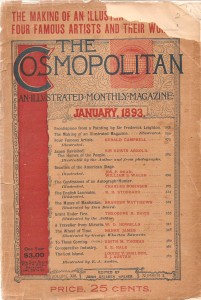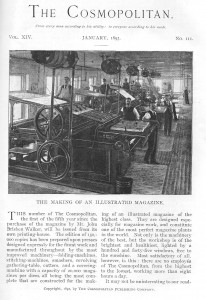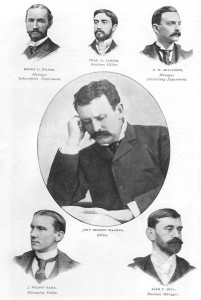Follow Scott
Recent Tweets
- Waiting for Twitter... Once Twitter is ready they will display my Tweets again.
Latest Photos
Search
Tags
anniversary Balticon birthdays Bryan Voltaggio Capclave comics Cons context-free comic book panel conventions DC Comics dreams Eating the Fantastic food garden horror Irene Vartanoff Len Wein Man v. Food Marie Severin Marvel Comics My Father my writing Nebula Awards Next restaurant obituaries old magazines Paris Review Readercon rejection slips San Diego Comic-Con Scarecrow science fiction Science Fiction Age Sharon Moody Stan Lee Stoker Awards StokerCon Superman ukulele Video Why Not Say What Happened Worldcon World Fantasy Convention World Horror Convention zombies
©2025 Scott Edelman
Magazine publishing circa 1893
Posted by: Scott
Tags:
old magazines, The Cosmopolitan
Posted date:
January 28, 2008 |
No comment
It’s said that the two things you should never see being made are sausages and the law, but to that list you should add magazines. It can be an ugly process. And yet the editors of The Cosmopolitan, one of the leading general-interest magazines in the country, decided to share their secrets with a lengthy article in the January issue.
That’s the January 1893 issue, as you can see by my somewhat tattered copy.
In an article titled “The Making of an Illustrated Magazine,” readers are taken through the entire publishing process, from start-up costs, to the difficulties of obtaining advertising, to that stack of unsolicited manuscripts that has existed at every magazine since the first issue of the first magazine was carved into stone tablets.
Here are a few choice excerpts from that 14-page article, which show that perhaps time really hasn’t changed things that much after all.
First, a look at the economics:
Probably there are few business enterprises of a more hazardous character than the establishment of an illustrated magazine. There are two or three very curious features which which place large odds against success. First, the magazine must be sold at less than cost from the year of its birth until it reaches a circulation approximating one hundred thousand copies. Upon the first copy of each issue there are fixed charges aggregating many thousands of dollars paid to authors and artists, for the services of editors, engravers, printers, electrotypers, et cetera, and these charges are constant, whether one copy or half a million be issued.
If The Cosmopolitan were confined to the average edition of the average book, the entire edition would have to be sold at more than five dollars a copy to bring cost price to the publisher. But with each thousand added to the edition of the magazine these fixed charges are divided into a smaller sum per copy until, at a hundred thousand, the figure becomes so small that the advertising receipts step in and turn the scale in favor of the publisher. In lots of 100,000 copies, the actual cost of a magazine of the character of The Cosmopolitan for paper, presswork, editorial services, mailing, and other expenses incidental to its publication is about eighteen cents per copy—more than the price at which it is sold to the American New Company. Apparently, the more copies sold the more money the publisher would lose; but the seeming paradox is explained by the advantage which the great advertisers of the world take of such a large circulation, and the deficiency of income from the hundred thousand copies is made good by the advertising pages, with a margin of profit left over.
So how much does it cost to launch a new periodical? And remember—these are 1893 dollars:
To make a readable magazine is not enough. People must be acquainted with its merits before they will even entertain the question of its purchase. What wonder that under these conditions more than a quarter of a million dollars was spent unavailingly upon The American Mercury, a hundred thousand in an attempt to establish The Manhattan, as much more upon Our Continent, and countless sums upon smaller monthlies with no result that was other than completely disastrous! A gentleman familiar with the establishment of one of the four successful illustrated magazines stated in the writer’s hearing recently that full half a million dollars had been made available at the starting of the enterprise and the last dollar had been called for just as success came.
And what of those unsolicited manuscripts?
The process of making a magazine begins with the arrival of th mail-carrier and his packages of manuscripts. Whether marked “personal,” “private,” “confidential,” or simply “Cosmopolitan Magazine,” they all go through the one channel, and are turned over to the registering clerk, who enters the names, date of arrival, character of the manuscript, author’s address, number of illustrations, and such other facts as are necessary for identification in a large book ruled and printed for that purpose. The manuscript is enclosed in a new envelope upon which a stamp in blank leaves an opportunity to enter the same information that is given in the registry book. From the registering clerk, they pass to the hands of an assistant editor, who gives each contribution a careful reading, and then sends to other readers for fresh judgment such manuscripts as seem to require supporting opinions.
The return of a manuscript does not imply that it is lacking in literary style or merit. The editor has in mind all that has been printed in the magazine during its entire existence, or in other magazines for the last half-dozen years, the manuscripts already in hand accepted, and finally the suitability of the manuscript to this special publication. In a word, a thousand considerations go to make up the decision upon which the acceptance or rejection depends, and excellent articles are often promptly rejected because of conditions, entirely foreign to their merits, which make their acceptance inadvisable.
Writers, do you feel better now?
The article concludes with this uplifting message:
It is not easy to exaggerate the influence which the four great magazines, Harper’s, Century, Scribner’s and The Cosmopolitan, have exerted upon the civilization and material progress of the United States. They have carried ennobling thoughts, and the results of the latest scientific investigations into the most remote hamlets. Nor can too much stress be laid upon the fact that they have been at all times untrammeled by any adverse advertising influence and free to consider the best interests of the whole people. As a consequence scarcely a home can be found that has not been refined, educated and made brighter and better by these magazines. As the reading classes grow—and the public schools are turning out their tens of thousands—the field of the magazine is extended. It is really a liberal educator, in art and in all branches of knowledge. It does not enter the field of politics, and can afford to have the good of the entire people at heart. As its advertisements have absolutely no connection whatever with the editing of the magazine, it can stand above all considerations except the highest good of its readers. That which is truest, that which is most elevating, that best calculated to educate and improve—these are the standard by which the editor may be guided, with the certainty that he will be supported by his readers.
Though the business side of magazine publishing seems unchanged, an examination of current magazine editorial content tells a different story.
This same January 1893 issue of The Cosmopolitan serializes the latest chapters of The Wheel of Time by Henry James and contains a travelogue on Japan by Sir Edwin Arnold. Flash forward 115 years, and the January 2008 issue of Cosmopolitan, the magazine’s current incarnation, includes the articles “Dirty Sexy Sex: Top Pleasure Experts Share Moves So New and Naughty You Could Only Read Them Here” and “Sex Sessions That Ended in the ER: You’ll Thank God It Wasn’t You.”
I wonder what the editorial staff (pictured above) would have made of it all!



